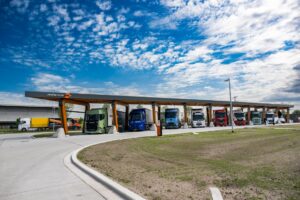Transportation is undergoing drastic changes with rapid technological advancements, intense discussions, and new regulations in the fight against climate change. During these turbulent times, it is important not to overlook the heartbeat of our highways. An ever-present part of the landscape of transportation are truck drivers. They are required to work long hours and often find themselves on the road for extended periods of time. Through wind and weather, they are critical in ensuring cargo arrives in time and in good condition at its destination. In the design process of the distinctive Milence charging hubs, truck drivers and sustainability form two of the most important pillars.
A distinctive reliable & user-friendly design, recognisable throughout Europe
Truck drivers will be able to recognise Milence charging hubs instantly because of the distinctive design. Milence’s charging hubs feature an arch, itself part of the company’s brand assets portfolio and owned and protected by Milence. The distinctive design is consistent throughout Europe. In addition, it adds an extra design mark to the charging hub alongside the company logo.
Currently, the majority of truck parking lots have a technical design in which trucks take centre stage. Milence wants to challenge this design feature and put the people behind the wheel at the forefront of the design process. In collaboration with architectural company Proof of the sum, Milence’s charging hubs go beyond the typical charging station, offering a unique blend of high-performance technology and a place of relaxation for the truck driver.
The experience of truck drivers is not just a feature but the core of the architectural design of the charging hubs. Truck drivers should feel welcome and safe when stopping and resting at the hubs. To create an optimal charging experience for the truck driver it is also necessary to enhance the quality of the locations. Therefore, Milence and Proof of the sum performed a deep dive into the life of a truck driver. By doing so, they ensured that every design choice was made from the point of view of the truck driver. for example, they conducted extensive research into geographical conditions such as scenery and weather conditions in Europe and how these affect the driver experience. As Milence’s charging network will be built across Europe; it is important that all hubs cater to local needs.

Sustainability at the core of the design
Sustainability is one of the most important core values of Milence. This commitment is also evident in the design of the Milence charging hubs. The material choices of the site focused on reducing CO2 emissions and the use of biobased materials. The primary material used in the design is wood. The canopy design is engineered in collaboration with Treetek a company specialising in modular timber building and engineering. Because most materials are prefabricated, the construction process is more streamlined and minimises on-site efforts.
A major topic in the discussion regarding electric transportation is the power grid. The sustainable design choices of Milence’s charging hub go beyond just the materials as each hub is designed to be as sustainable as possible. The hubs also therefore have the option to have solar panels incorporated into the roof and battery packages for local storage. This aligns with Milence’s commitment to creating a responsible and eco-conscious infrastructure. Also the installation of big batteries on site will be the case on a part of the hubs. With this solution Milence will minimise the pressure on the grid.
Mike Kok, brand manager at Milence said: “People are at the heart of our design. Truck drivers are often on the road for long periods of time. Come rain or shine, they ensure our cargo arrives timely and safely. With the Milence charging hubs, we aimed to produce a solution for the people who take care of transporting our goods. And provide them with an optimal charging and resting experience.”
Roy Pype, architect at Proof of the Sum said: “Rather than making design choices based on the logistics of truck parking, Milence prioritised the needs of truck drivers and the impact of the charging hubs on the environment. They designed not just functional parking spaces but desirable stops. With the charging hubs, Milence wants to show that electric transportation not only improves the road but also improves the life of truck drivers on the road.
But next to the driver’s experience, you can think differently in many unexpected aspects with electric transportation. For example, the advantages of electric transportation are not just fuel related. Truck parkings must consider leakage which is not the case for electric trucks. Thus making them more environmentally friendly when it comes to run-off that can pollute the ground water. The charging hubs are where sustainable technology and user experience come together.”



